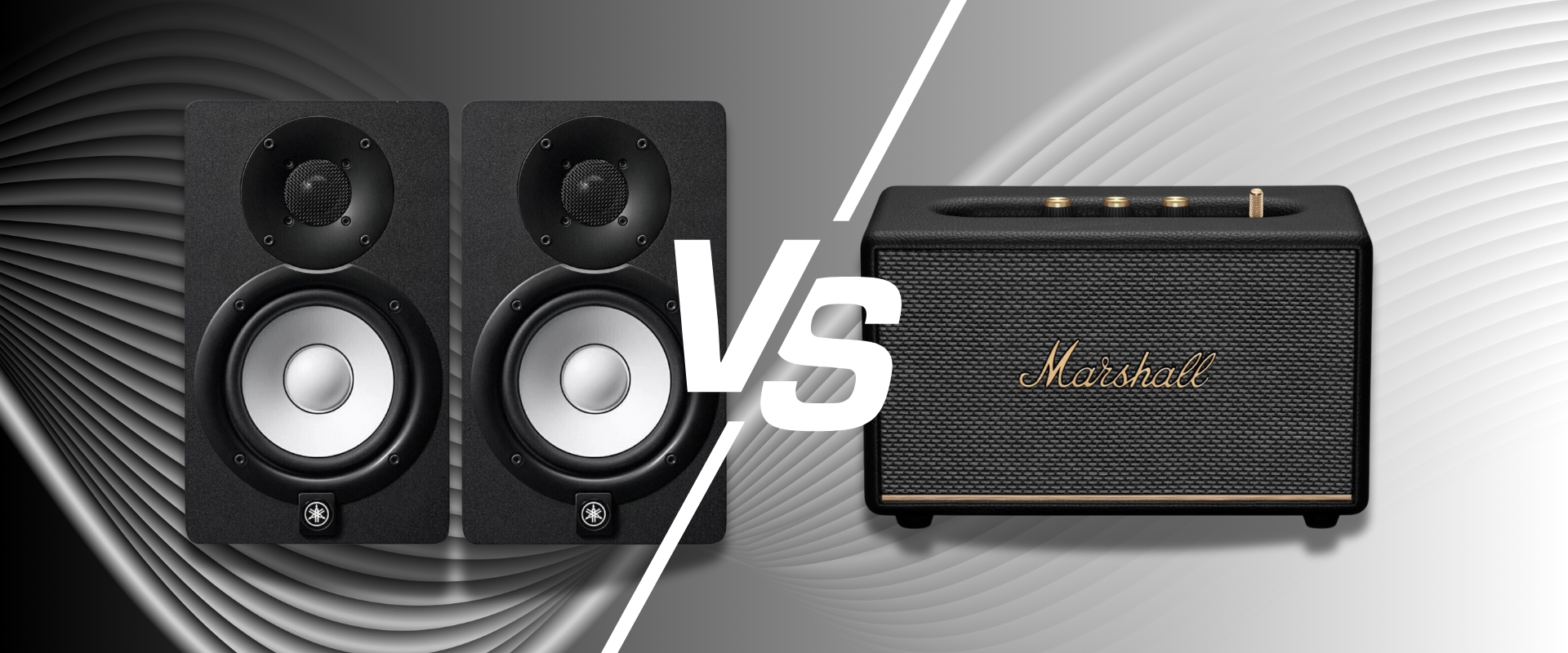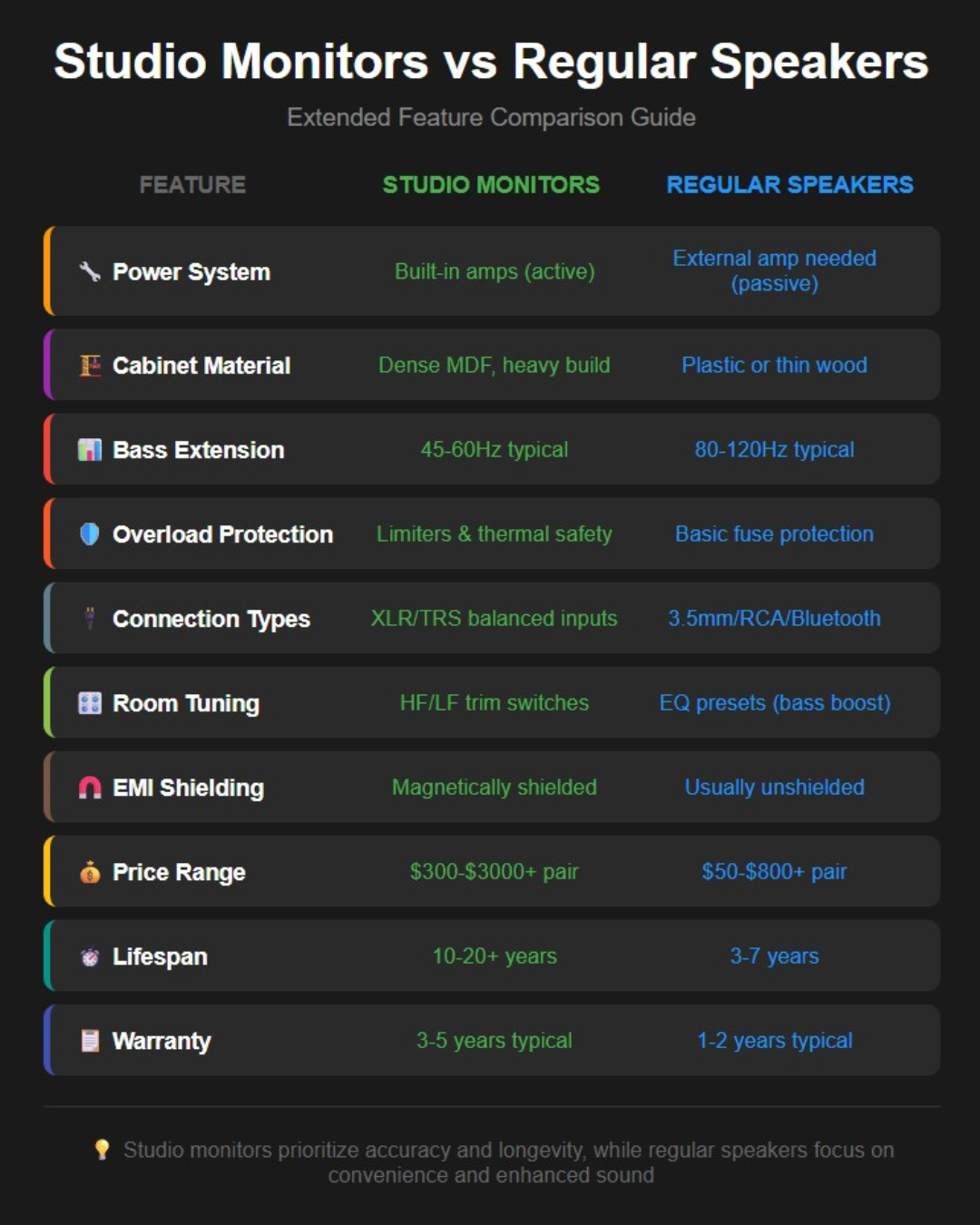Studio Monitors vs. Regular Speakers
What's the Real Difference for Artists?
I see this question constantly from talented artists ready to level up. They create a fire track that sounds amazing on their desktop speakers, but then it sounds muddy in their car and thin on their AirPods. It's a frustrating problem that I, Luke Mounthill, had to solve early in my own production journey before I could get my beats to a professional, radio-ready standard. This guide is the answer to that problem.
The fundamental difference comes down to this: studio monitors are your brutally honest friend, while regular speakers are your flattering friend. One tells you the truth so you can fix problems before the world hears them. The other makes everything sound good, even when it isn't. Understanding this distinction will transform how you approach music production and help you create tracks that sound professional everywhere.
|
|
Regular Speakers (The Flattering Friend) | ||
|---|---|---|---|---|
| Primary Goal | Accurate sound reproduction |
|
||
| Frequency Response |
|
|
||
| Best For |
|
|
||
| Design Philosophy |
|
|
What Are Studio Monitors, and Why Do They Matter?
Studio monitors are specialized speakers designed for one primary purpose: to reproduce sound as accurately as possible without adding any coloration or enhancement. They're the essential tool for music production, mixing, and mastering because they reveal the true character of your audio.
The defining characteristic of studio monitors is their flat frequency response. This means they reproduce all frequencies - from the lowest bass to the highest treble - at equal volume levels. Unlike consumer speakers that artificially boost certain frequencies to make music sound more exciting, studio monitors present audio exactly as it was recorded.
How Do Regular Speakers Enhance Your Music?
Regular speakers, whether they're in your car, home theater system, or Bluetooth portable unit, are engineered with a completely different philosophy. Manufacturers like Bose, Sonos, and Sony design these speakers to make music sound impressive and enjoyable for casual listening.
Consumer speakers typically employ what audio engineers call a "smiley face" frequency curve. They boost the bass frequencies to add punch and excitement, while also enhancing the high frequencies to create sparkle and presence. This colored sound makes your favorite songs sound fuller and more dynamic, but it masks the true nature of the audio.
Why Is Flat Frequency Response Your Secret Weapon?
Think about it this way: if you're mixing on speakers that add extra bass, you'll naturally reduce the bass in your mix to compensate. But when someone plays your track on a system without that bass boost, your mix will sound thin and weak. This is why your beats might sound perfect in your room but fall apart everywhere else.
A flat frequency response ensures that what you hear is what's actually in your recording. When professional engineers talk about a mix that "translates well," they mean it sounds consistent across different playback systems. This translation happens because the mix was created on accurate monitors that didn't lie about the frequency balance.
What Does "Nearfield" Mean, and Why Should You Care?
Most studio monitors are designed as nearfield monitors, meaning they're optimized for close listening distances - typically 3 to 8 feet from your ears. This design philosophy has several advantages for home studio producers.
Nearfield monitoring minimizes the acoustic influence of your room. When you sit close to the speakers, you hear more direct sound from the monitors and less reflected sound bouncing off the walls. This gives you a clearer picture of your mix without needing extensive acoustic treatment.
Regular speakers are often designed for far-field listening, where they need to fill an entire room with sound. They're optimized to sound good from various positions and distances, which requires different engineering compromises.
How Do Active and Passive Speakers Impact Your Setup?
Studio monitors typically come in active configurations, meaning they have built-in amplifiers specifically matched to their drivers. According to the experts at Palmer, this integration ensures optimal performance and eliminates the guesswork of pairing speakers with external amplifiers. You'll recognize active monitors by the power cable and volume controls on the back panel.
Consumer speakers more commonly use passive designs, requiring a separate amplifier or receiver. While this offers flexibility in choosing your amplification, it also introduces another variable that can color your sound. For accurate monitoring, the simplicity and precision of active monitors provide a significant advantage.
Can You Mix Music on Regular Speakers?
Technically, yes - but you're making your job much harder. Mixing on colored speakers is like editing photos while wearing tinted glasses. You might think you're making the right adjustments, but you're actually compensating for distortions that don't exist in the original material.
Some legendary engineers have famously mixed hit records on unconventional speakers. The Yamaha NS10, originally marketed as a home hi-fi speaker, became a studio standard despite (or perhaps because of) its unflattering sound. However, these engineers spent years learning exactly how their chosen speakers translated to other systems.
What Makes Some Studio Monitors Better Than Others?
Here's where things get interesting. If all studio monitors aim for a flat response, shouldn't they all sound identical? The reality is that achieving true flatness is physically impossible. Every monitor has some deviation from perfect linearity.
Premium monitors minimize these deviations through superior engineering. They use high-quality drivers, sophisticated crossover networks, and rigid cabinet construction to reduce unwanted resonances.
The Yamaha HS5, for example, has a quoted frequency response of 54Hz-30kHz at -10dB, with a tighter range of 74Hz-24kHz at -3dB. These specifications tell you not just what frequencies the monitor can reproduce, but how accurately it reproduces them across the spectrum.
Should You Use Studio Monitors for Casual Listening?
This question divides the audio community. Studio monitors can provide an incredibly detailed and revealing listening experience. You'll hear elements in your favorite songs that you never noticed before - both good and bad. Every production flaw becomes apparent, which can be either fascinating or frustrating.
Many audio professionals report listening fatigue when using studio monitors for extended casual listening. The unforgiving accuracy that makes them perfect for critical work can make them less enjoyable for relaxation. It's the difference between a magnifying glass and rose-colored glasses - both have their place.
What Should You Look For When Buying Your First Studio Monitors?
Choosing your first monitors requires balancing several practical considerations with your specific needs:
Woofer Size: Five-inch woofers are great for small rooms, while 8-inch models provide fuller bass but may overwhelm untreated spaces.
Bass Port Position: Front-firing ports allow placement closer to walls, while rear-firing ports need more space.
Input Options: Look for professional XLR and TRS connections for the best signal quality.
Room size directly impacts your choice. Bigger woofers aren't always better - they can overwhelm small spaces with excessive bass that muddies your mix. Consider your actual working environment before choosing.
How Do Room Acoustics Affect Your Monitoring?
Even the best studio monitors can't overcome poor room acoustics. Untreated rooms create standing waves, flutter echoes, and frequency buildups that color what you hear. This is why many affordable monitors include room correction switches to compensate for common placement issues.
The Yamaha HS series, for instance, includes room control settings that adjust the low-frequency response when monitors must be placed near walls. While these controls help, they're not substitutes for proper acoustic treatment and thoughtful speaker positioning.
Why Do Professionals Still Reference Consumer Systems?
Here's a professional secret: even with the best studio monitors, engineers still check their mixes on consumer systems. They'll play tracks through a variety of systems, including:
Car stereos
Standard earbuds (like Apple's)
Phone speakers
Consumer home theater systems
This practice acknowledges that most listeners will hear your music on consumer playback systems, not studio monitors. The goal isn't to make your mix sound perfect on studio monitors - it's to use their accuracy to create mixes that sound great everywhere.
What about the Technical Specifications?
Understanding monitor specifications helps you make informed decisions, though marketing departments sometimes obscure the truth. Frequency response charts tell the real story, but only when they include tolerance values.
A specification like "45Hz-22kHz ±3dB" means more than "40Hz-40kHz" without tolerance values. The ±3dB indicates how much the response deviates from flat across the stated range. Tighter tolerances (±1.5dB) indicate more accurate reproduction.
Power ratings matter less than you might think for nearfield monitoring. A well-designed 50-watt monitor often outperforms a poorly designed 100-watt model. Focus on overall system design rather than chasing specifications.
Making Your Choice: Accuracy or Enhancement?
The choice between studio monitors and regular speakers ultimately depends on your goals. If you're serious about producing, mixing, or mastering music, studio monitors are essential tools. They provide the accurate foundation necessary for creating professional-sounding tracks.
For casual listening, regular speakers often provide a more enjoyable experience. They're designed to make music sound impressive without revealing every flaw. There's nothing wrong with owning both types of speakers for different purposes.
Remember that studio monitors are tools, not magic solutions. They reveal problems in your mixes, but you still need to develop the skills to fix those problems. Investing in quality monitors is just the first step in your journey toward professional-sounding productions.
Frequently Asked Questions About Studio Monitors
-
While quality headphones like the Audio-Technica ATH-M50x are essential for checking details, they don't replicate how a mix sounds in a room. You need monitors to properly judge stereo imaging and low-end translation. The best practice is to use both.
-
For most home studios, a subwoofer is not necessary and can often create more acoustic problems than it solves. Start with a quality pair of 5-inch or 8-inch monitors and only add a sub once you have proper acoustic treatment.
-
A quality entry-level pair of studio monitors typically costs between $300 and $500. Investing in this range ensures you get a reasonably flat frequency response and reliable build quality that you won't outgrow immediately.
-
Two-way monitors have a woofer and tweeter, while 3-way designs add a dedicated midrange driver. Most home studio applications work perfectly with 2-way designs, which offer simpler crossover networks and often better phase coherence.
-
Digital Signal Processing (DSP) can help compensate for room problems, but it's not a magic fix. Monitors with built-in DSP like the Genelec GLM system or KRK's app-controlled models can improve accuracy, but basic acoustic treatment remains more important.





















